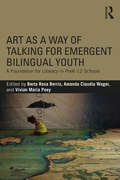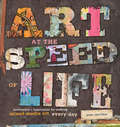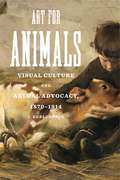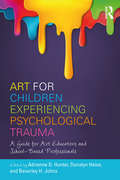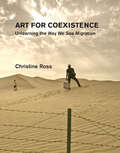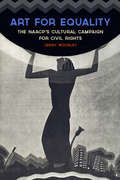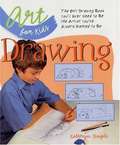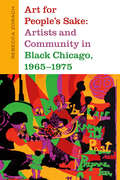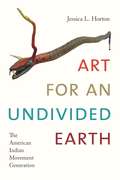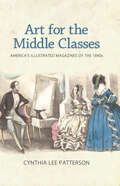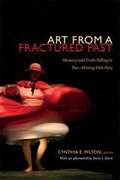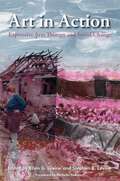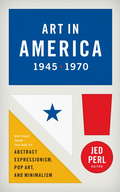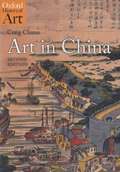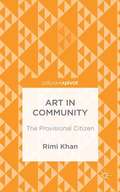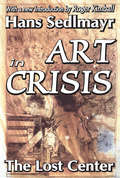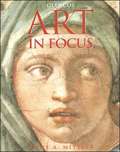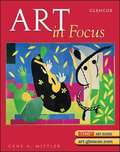- Table View
- List View
Art as a Way of Talking for Emergent Bilingual Youth: A Foundation for Literacy in PreK-12 Schools
by Berta Rosa Berriz Amanda Claudia Wager Vivian Maria PoeyThis book features effective artistic practices to improve literacy and language skills for emergent bilinguals in PreK-12 schools. Including insights from key voices from the field, this book highlights how artistic practices can increase proficiency in emergent language learners and students with limited access to academic English. Challenging current prescriptions for teaching English to language learners, the arts-integrated framework in this book is grounded in a sense of student and teacher agency and offers key pedagogical tools to build upon students’ sociocultural knowledge and improve language competence and confidence. Offering rich and diverse examples of using the arts as a way of talking, this volume invites teacher educators, teachers, artists, and researchers to reconsider how to fully engage students in their own learning and best use the resources within their own multilingual educational settings and communities.
Art at the Speed of Life: motivation + inspiration for making mixed-media art every day
by Pam CarrikerOffering terrific mixed-media art projects, as well as great tips for getting organized and inspired, Art at the Speed of Life is a treasure chest of ideas for the artist whose fiery enthusiasm for creating art goes up in smoke after that frantic pace of a long day. Author and mixed-media artist Pam Carriker will prove to you that art and life can co-exist productively and happily, while making daily creative outlets a reality and not just wishful thinking.Each chapter in Art at the Speed of Life includes both essays and project ideas from a variety of contributors, including Suzi Blu, Lisa Bebi, Christy Hydeck, Paulette Insall, Cate Calacous Prato. It all begins with prepatory advice on how to manage your supplies and physically make space for you to work. This is followed by more than 15 projects that are inspiring, yet easy to complete on even the tightest of schedules and includes fun techniques such as assemblages, image transfers, and collages that are sure to keep you motivated. Plus, a bonus seven-day project journal helps you track your work as you go. Offering a unique combination of realistic time-management tips, inspiring essays, and easy-to-fit-in projects, Art at the Speed of Life will help you realize your dream of making art every day easily and happily.
Art before the Law
by Ruth RonenEver since Plato expelled the poets from his ideal state, the ethics of art has had to confront philosophy's denial of art's morality. In Art before the Law, Ruth Ronen proposes a new outlook on the ethics of art by arguing that art insists on this tradition of denial, affirming its singular ethics through negativity.Ronen treats the mechanism of negation as the basis for the relationship between art and ethics. She shows how, through moves of denial, resistance, and denouncement, art exploits its negative relation to morality. While deception, fiction, and transgression allegedly locate art outside morality and ethics, Ronen argues they enable art to reveal the significance of the moral law, its origins, and the idea of the good. By employing the thought of Freud and Lacan, Ronen reconsiders the aesthetic tradition from Plato through Kant and later philosophers of art in order to establish an ethics of art. An interdisciplinary study, Art before the Law is sure to be of interest both to academic philosophers and to those interested in psychoanalytic theory and practice.
Art beyond Itself: Anthropology for a Society without a Story Line
by David Frye Néstor García CancliniFirst published in Spanish in 2010, Art beyond Itself is Néstor García Canclini's deft assessment of contemporary art. The renowned cultural critic suggests that, ideally, art is the place of imminence, the place where we glimpse something just about to happen. Yet, as he demonstrates, defining contemporary art and its role in society is an ever more complicated endeavor. Museums, auction houses, artists, and major actors in economics, politics, and the media are increasingly chummy and interdependent. Art is expanding into urban development and the design and tourism industries. Art practices based on objects are displaced by practices based on contexts. Aesthetic distinctions dissolve as artworks are inserted into the media, urban spaces, digital networks, and social forums. Oppositional artists are adrift in a society without a clear story line. What, after all, counts as transgression in a world of diverse and fragmentary narratives? Seeking a new analytic framework for understanding contemporary art, García Canclini is attentive to particular artworks; to artists including Francis Alÿs, León Ferrari, Teresa Margolles, Antoni Muntadas, and Gabriel Orozco; and to efforts to preserve, for art and artists, some degree of independence from religion, politics, the media, and the market.
Art for Animals: Visual Culture and Animal Advocacy, 1870–1914 (Animalibus)
by J. Keri CroninAnimal rights activists today regularly use visual imagery in their efforts to shape the public’s understanding of what it means to be “kind,” “cruel,” and “inhumane” toward animals. Art for Animals explores the early history of this form of advocacy through the images and the people who harnessed their power.Following in the footsteps of earlier-formed organizations like the RSPCA and ASPCA, animal advocacy groups such as the Victoria Street Society for the Protection of Animals from Vivisection made significant use of visual art in literature and campaign materials. But, enabled by new and improved technologies and techniques, they took the imagery much further than their predecessors did, turning toward vivid, pointed, and at times graphic depictions of human-animal interactions. Keri Cronin explains why the activist community embraced this approach, details how the use of such tools played a critical role in educational and reform movements in the United States, Canada, and England, and traces their impact in public and private spaces. Far from being peripheral illustrations of points articulated in written texts or argued in impassioned speeches, these photographs, prints, paintings, exhibitions, “magic lantern” slides, and films were key components of animal advocacy at the time, both educating the general public and creating a sense of shared identity among the reformers.Uniquely focused on imagery from the early days of the animal rights movement and filled with striking visuals, Art for Animals sheds new light on the history and development of modern animal advocacy.
Art for Animals: Visual Culture and Animal Advocacy, 1870–1914 (Animalibus: Of Animals and Cultures #12)
by J. Keri CroninAnimal rights activists today regularly use visual imagery in their efforts to shape the public’s understanding of what it means to be “kind,” “cruel,” and “inhumane” toward animals. Art for Animals explores the early history of this form of advocacy through the images and the people who harnessed their power.Following in the footsteps of earlier-formed organizations like the RSPCA and ASPCA, animal advocacy groups such as the Victoria Street Society for the Protection of Animals from Vivisection made significant use of visual art in literature and campaign materials. But, enabled by new and improved technologies and techniques, they took the imagery much further than their predecessors did, turning toward vivid, pointed, and at times graphic depictions of human-animal interactions. Keri Cronin explains why the activist community embraced this approach, details how the use of such tools played a critical role in educational and reform movements in the United States, Canada, and England, and traces their impact in public and private spaces. Far from being peripheral illustrations of points articulated in written texts or argued in impassioned speeches, these photographs, prints, paintings, exhibitions, “magic lantern” slides, and films were key components of animal advocacy at the time, both educating the general public and creating a sense of shared identity among the reformers.Uniquely focused on imagery from the early days of the animal rights movement and filled with striking visuals, Art for Animals sheds new light on the history and development of modern animal advocacy.
Art for Children Experiencing Psychological Trauma: A Guide for Art Educators and School-Based Professionals
by Beverley H. Johns Adrienne D. Hunter Donalyn HeiseArt for Children Experiencing Psychological Trauma aims to increase understanding of art’s potential to enhance learning for children living in crisis. In this ground-breaking resource, the first of its kind to focus specifically on the connection between art education and psychological trauma in youth populations, readers can find resources and practical strategies for both teachers and other school-based professionals. Also included are successful models of art education for diverse populations, with specific attention to youth who face emotional, mental, behavioral, and physical challenges, as well a framework for meaningful visual arts education for at-risk/in-crisis populations.
Art for Coexistence: Unlearning the Way We See Migration
by Christine RossAn exploration of how contemporary art reframes and humanizes migration, calling for coexistence—the recognition of the interdependence of beings.In Art for Coexistence, art historian Christine Ross examines contemporary art&’s response to migration, showing that art invites us to abandon our preconceptions about the current &“crisis&”—to unlearn them—and to see migration more critically, more disobediently. We (viewers in Europe and North America) must come to see migration in terms of coexistence: the interdependence of beings. The artworks explored by Ross reveal, contest, rethink, delink, and relink more reciprocally the interdependencies shaping migration today—connecting citizens-on-the-move from some of the poorest countries and acknowledged citizens of some of the wealthiest countries and democracies worldwide. These installations, videos, virtual reality works, webcasts, sculptures, graffiti, paintings, photographs, and a rescue boat, by artists including Banksy, Ai Weiwei, Alejandro González Iñárritu, Laura Waddington, Tania Bruguera, and others, demonstrate art&’s power to mediate experiences of migration. Ross argues that art invents a set of interconnected calls for more mutual forms of coexistence: to historicize, to become responsible, to empathize, and to story-tell. Art history, Ross tells us, must discard the legacy of imperialist museology—which dissocializes, dehistoricizes, and depoliticizes art. It must reinvent itself, engaging with political philosophy, postcolonial, decolonial, Black, and Indigenous studies, and critical refugee and migrant studies.
Art for Equality: The NAACP's Cultural Campaign for Civil Rights (Civil Rights and the Struggle for Black Equality in the Twentieth Century)
by Jenny WoodleyA study of the NAACP’s activism in the cultural realm through creative projects from 1910 to the 1960s.The National Association for the Advancement of Colored People (NAACP) is the nation’s oldest civil rights organization, having dedicated itself to the fight for racial equality since 1909. While the group helped achieve substantial victories in the courtroom, the struggle for civil rights extended beyond gaining political support. It also required changing social attitudes. The NAACP thus worked to alter existing prejudices through the production of art that countered racist depictions of African Americans, focusing its efforts not only on changing the attitudes of the White middle class but also on encouraging racial pride and a sense of identity in the Black community.Art for Equality explores an important and little-studied side of the NAACP’s activism in the cultural realm. In openly supporting African American artists, writers, and musicians in their creative endeavors, the organization aimed to change the way the public viewed the Black community. By overcoming stereotypes and the belief of the majority that African Americans were physically, intellectually, and morally inferior to Whites, the NAACP believed it could begin to defeat racism.Illuminating important protests, from the fight against the 1915 film The Birth of a Nation to the production of anti-lynching art during the Harlem Renaissance, this insightful volume examines the successes and failures of the NAACP’s cultural campaign from 1910 to the 1960s. Exploring the roles of gender and class in shaping the association's patronage of the arts, Art for Equality offers an in-depth analysis of the social and cultural climate during a time of radical change in America.Praise for Art for Equality“A well-conceived and well-executed study that will add significantly to the historiography of the NAACP, the long civil rights movement, and African American history.” —John Kirk, George W. Donaghey Professor and Chair of the History Department at the University of Arkansas at Little Rock“In this insightful book, Woodley writes with great verve and confidence. As a result, Art for Equality will attract readers in a variety of fields from African American history to art history to American political history.” —Matthew Pratt Guterl, Brown University“A necessary contribution to African American social and cultural histories.” —Journal of Southern History
Art for Kids Drawing
by Kathryn TempleWith the help of lots of exercises, budding artists will learn the basic elements of shapes (lines, dots, circles) and see how to combine them to make familiar forms. They'll find out how to produce the illusion of volume with shading techniques; create perspective; accurately recreate landscapes, people, animals, and nature; develop interesting compositions; and more.
Art for Kids: Become the Artist Only You Can Be (Art for Kids)
by Kathryn Temple&“This is a gold mine of information for any kid that doodles.&”—Library Media Connection This companion volume to Art for Kids: Drawing builds on skills taught in the first book, focusing on the integrating and big picture skills of drawing and the creative process. These include style, composition, content selection, sources of inspiration, quality of line (loose and gestural vs. clean and tight), as well as grounding and contextualizing subjects. Filled with clear instructions, easy-to-use techniques, and a wealth of encouragement, get ready to make great original drawings. You&’ll be amazed by the art they can create!
Art for People's Sake: Artists and Community in Black Chicago, 1965-1975
by Rebecca ZorachIn the 1960s and early 1970s, Chicago witnessed a remarkable flourishing of visual arts associated with the Black Arts Movement. From the painting of murals as a way to reclaim public space and the establishment of independent community art centers to the work of the AFRICOBRA collective and Black filmmakers, artists on Chicago's South and West Sides built a vision of art as service to the people. In Art for People's Sake Rebecca Zorach traces the little-told story of the visual arts of the Black Arts Movement in Chicago, showing how artistic innovations responded to decades of racist urban planning that left Black neighborhoods sites of economic depression, infrastructural decay, and violence. Working with community leaders, children, activists, gang members, and everyday people, artists developed a way of using art to help empower and represent themselves. Showcasing the depth and sophistication of the visual arts in Chicago at this time, Zorach demonstrates the crucial role of aesthetics and artistic practice in the mobilization of Black radical politics during the Black Power era.
Art for an Undivided Earth: The American Indian Movement Generation
by Jessica L. HortonIn Art for an Undivided Earth Jessica L. Horton reveals how the spatial philosophies underlying the American Indian Movement (AIM) were refigured by a generation of artists searching for new places to stand. Upending the assumption that Jimmie Durham, James Luna, Kay WalkingStick, Robert Houle, and others were primarily concerned with identity politics, she joins them in remapping the coordinates of a widely shared yet deeply contested modernity that is defined in great part by the colonization of the Americas. She follows their installations, performances, and paintings across the ocean and back in time, as they retrace the paths of Native diplomats, scholars, performers, and objects in Europe after 1492. Along the way, Horton intervenes in a range of theories about global modernisms, Native American sovereignty, racial difference, archival logic, artistic itinerancy, and new materialisms. Writing in creative dialogue with contemporary artists, she builds a picture of a spatially, temporally, and materially interconnected world—an undivided earth.
Art for the Fun of It: A Guide for Teaching Young Children
by Peggy D. JenkinsThe book is directed toward those involved with children in the 3 through 8 age group, although there is no upper age limit for the use of most of these materials. The reader will gain a good foundation in the philosophy of art as it pertains to the child of this age group and will be able to share more understandingly the child's joy in artistic expression.
Art for the Middle Classes: America's Illustrated Magazines of the 1840s
by Cynthia Lee PattersonHow did the average American learn about art in the mid-nineteenth century? With public art museums still in their infancy, and few cities and towns large enough to support art galleries or print shops, Americans relied on mass-circulated illustrated magazines. One group of magazines in particular, known collectively as the Philadelphia pictorials, circulated fine art engravings of paintings, some produced exclusively for circulation in these monthlies, to an eager middle-class reading audience. These magazines achieved print circulations far exceeding those of other print media (such as illustrated gift books or catalogs from art-union membership organizations). Godey's, Graham's, Peterson's, Miss Leslie's, and Sartain's Union Magazine included two to three fine art engravings monthly, “tipped in” to the fronts of the magazines, and designed for pull-out and display. Featuring the work of a fledgling group of American artists who chose American rather than European themes for their paintings, these magazines were crucial to the distribution of American art beyond the purview of the East Coast elite to a widespread middle-class audience. Contributions to these magazines enabled many American artists and engravers to earn, for the first time in the young nation's history, a modest living through art. Author Cynthia Lee Patterson examines the economics of artistic production, innovative engraving techniques, regional imitators, the textual “illustrations” accompanying engravings, and the principal artists and engravers contributing to these magazines.
Art from Trash (Fountas & Pinnell Classroom, Guided Reading Grade 1)
by Danielle BerkowNIMAC-sourced textbook
Art from a Fractured Past: Memory and Truth Telling in Post–Shining Path Peru
by Cynthia E. MiltonPeru's Truth and Reconciliation Commission not only documented the political violence of the 1980s and 1990s but also gave Peruvians a unique opportunity to examine the causes and nature of that violence. In Art from a Fractured Past, scholars and artists expand on the commission's work, arguing for broadening the definition of the testimonial to include various forms of artistic production as documentary evidence. Their innovative focus on representation offers new and compelling perspectives on how Peruvians experienced those years and how they have attempted to come to terms with the memories and legacies of violence. Their findings about Peru offer insight into questions of art, memory, and truth that resonate throughout Latin America in the wake of "dirty wars" of the last half century. Exploring diverse works of art, including memorials, drawings, theater, film, songs, painted wooden retablos (three-dimensional boxes), and fiction, including an acclaimed graphic novel, the contributors show that art, not constrained by literal truth, can generate new opportunities for empathetic understanding and solidarity.Contributors. Ricardo Caro Cárdenas, Jesús Cossio, Ponciano del Pino, Cynthia M. Garza, Edilberto Jímenez Quispe, Cynthia E. Milton, Jonathan Ritter, Luis Rossell, Steve J. Stern, María Eugenia Ulfe, Víctor Vich, Alfredo Villar
Art in Action
by Stephen K. Levine Ellen G. LevineThe field of expressive arts is closely tied to the work of therapeutic change. As well as being beneficial for the individual or small group, expressive arts therapy has the potential for a much wider impact, to inspire social action and bring about social change. The book's contributors explore the transformative power of the arts therapies in areas stricken by conflict, political unrest, poverty or natural disaster and discuss how and why expressive arts works. They look at the ways it can be used to engage community consciousness and improve social conditions whilst taking into account the issues that arise within different contexts and populations. Leading expressive arts therapy practitioners give inspiring accounts of their work, from using poetry as a tool in trauma intervention with Iraqi survivors of war and torture, to setting up storytelling workshops to aid the integration of Ethiopian Jewish immigrants in Israel. Offering visionary perspectives on the role of the arts in inspiring change at the community or social level, this is essential reading for students and practitioners of creative and expressive arts therapies, as well as psychotherapists, counsellors, artists and others working to effect social change.
Art in America 1945-1970: Writings from the Age of Abstract Expressionism, Pop A
by Various Jed PerlExperience the creative explosion that transformed American art, in the words of the artists, writers, and critics who were there: In the quarter century after the end of World War II, a new generation of painters, sculptors, and photographers transformed the face of American art and shifted the center of the art world from Paris to New York. Signaled by the triumph of abstraction and the ascendancy of painters such as Pollock, Rothko, de Kooning, and Kline, this revolution generated an exuberant and contentious body of writing without parallel in our cultural history. In the words of editor Jed Perl, "there has never been a period when the visual arts have been written about with more mongrel energy--with more unexpected mixtures of reportage, rhapsody, analysis, advocacy, editorializing, and philosophy." Perl has gathered the best of this writing together for the first time, interwoven with fascinating headnotes that establish the historical background, the outsized personalities of the artists and critics, and the nature of the aesthetic battles that defined the era. Here are statements by the most significant artists, and major critical essays by Clement Greenberg, Susan Sontag, Hilton Kramer, and other influential figures. Here too is an electrifying array of responses by poets and novelists, reflecting the free interplay between different art forms: John Ashbery on Andy Warhol, James Agee on Helen Levitt, James Baldwin on Beauford Delaney, Truman Capote on Richard Avedon, Tennessee Williams on Hans Hofmann, Jack Kerouac on Robert Frank. The atmosphere of the time comes to vivid life in memoirs, diaries, and journalism by Peggy Guggenheim, Dwight Macdonald, Calvin Tomkins, and others. Lavishly illustrated with scores of black-and-white images and a 32-page color insert, this is a book that every art lover will treasure.
Art in China (2nd Edition)
by Craig ClunasChina boasts a history of art lasting over 5,000 years and embracing a huge diversity of forms - objects of jade, lacquer and porcelain, painted scrolls and fans, sculptures in stone, bronze and wood, and murals. But this rich tradition has not, until now been fully appreciated in the West where scholars have focused attention on the European high arts of painting and sculpture, downplaying arts more highly prized by the Chinese themselves, such as calligraphy. Art in China marks a breakthrough in the study of the subject. Drawing on recent innovative scholarship - and newly-accessible studies in China itself - Craig Clunas surveys the full spectrum of the visual arts in China. He ranges from the Neolithic period to the art scene of the early 21st century,examining Chinese art in a variety of contexts - as it has been designed for tombs, commissioned by rulers, displayed in temples, created by the men and women of the educated elite, and bought and sold in the marketplace. This updated edition contains expanded coverage of modern and contemporaryart, from the fall of the empire in 1911 to the growing international interest in the art of an increasingly confident and booming China.
Art in Community: The Provisional Citizen
by Rimi KhanThe arts are situated at the centre of policies and programs seeking to make communities more creative, cohesive or productive. This book highlights the governmental, aesthetic and economic contexts which shape art in community, offering a constructive account of the ties between government, culture and the citizen.
Art in Crisis: The Lost Center
by Hans SedlmayrThe history of art from the early nineteenth century on- ward is commonly viewed as a succession of conflicts between innovatory and established styles that culminated in the formalism and aesthetic autonomy of high modernism. In Art and Crisis, first published in 1948, Hans Sedlmayr argues that the aesthetic disjunctures of modern art signify more than matters of style and point to much deeper processes of cultural and religious disintegration. As Roger Kimball observes in his informative new introduction, Art in Crisis is as much an exercise in cultural or spiritual analysis as it is a work of art history. Sedlmayr's reads the art of the last two centuries as a fever chart of the modern age in its greatness and its decay. He discusses the advent of Romanticism with its freeing of the imagination as a conscious sundering of art from humanist and religious traditions with the aesthetic treated as a category independent of human need. Looking at the social purposes of architecture, Sedlmayr shows how the landscape garden, the architectural monument, and the industrial exhibition testified to a new relationship not only between man and his handiwork but also between man and the forces that transcend him. In these institutions man deifies his inventive powers with which he hopes to master and supersede nature. Likewise, the art museum denies transcendence through a cultural leveling in which Heracles and Christ become brothers as objects of aesthetic contemplation. At the center of Art in Crisis is the insight that, in art as in life, the pursuit of unqualified autonomy is in the end a prescription for disaster, aesthetic as well as existential. Sedlmayr writes as an Augustinian Catholic. For him, the underlying motive for the pursuit of autonomy is pride. The lost center of his subtitle is God. The dream of autonomy, Sedlmayr argues, is for finite, mortal creatures, a dangerous illusion. The book invites serious analysis from art cri
Art in Focus (4th Edition)
by Gene A. MittlerTHE MOST IMPRESSIVE AND ACCESSIBLE ART PROGRAM AVAILABLECompletely redesigned, Art in Focus is filled with colorful reproductions, photographs, graphics, and student artwork, all designed to challenge, surprise, and inspire your students to create and appreciate art. Your students expect something a little different from art class. The 2000 edition of Art In Focus offers the kind of inspiration and challenge your students expect. It is filled with more colorful reproductions, photos, and graphics than ever before. It uses both words and graphics to highlight relevant art topics. It integrates technology resources. It even features student artwork, so your students can see that talent can be celebrated and acknowledged at any age.
Art in Focus: Aesthetics, Criticism, History, Studio (5th edition)
by Gene A. MittlerArt in Focus - the premier high school art history text! An integrated, chronological approach to the study of art, Art in Focus demonstrates the interrelationships of aesthetics, art criticism, art history, and studio art.
